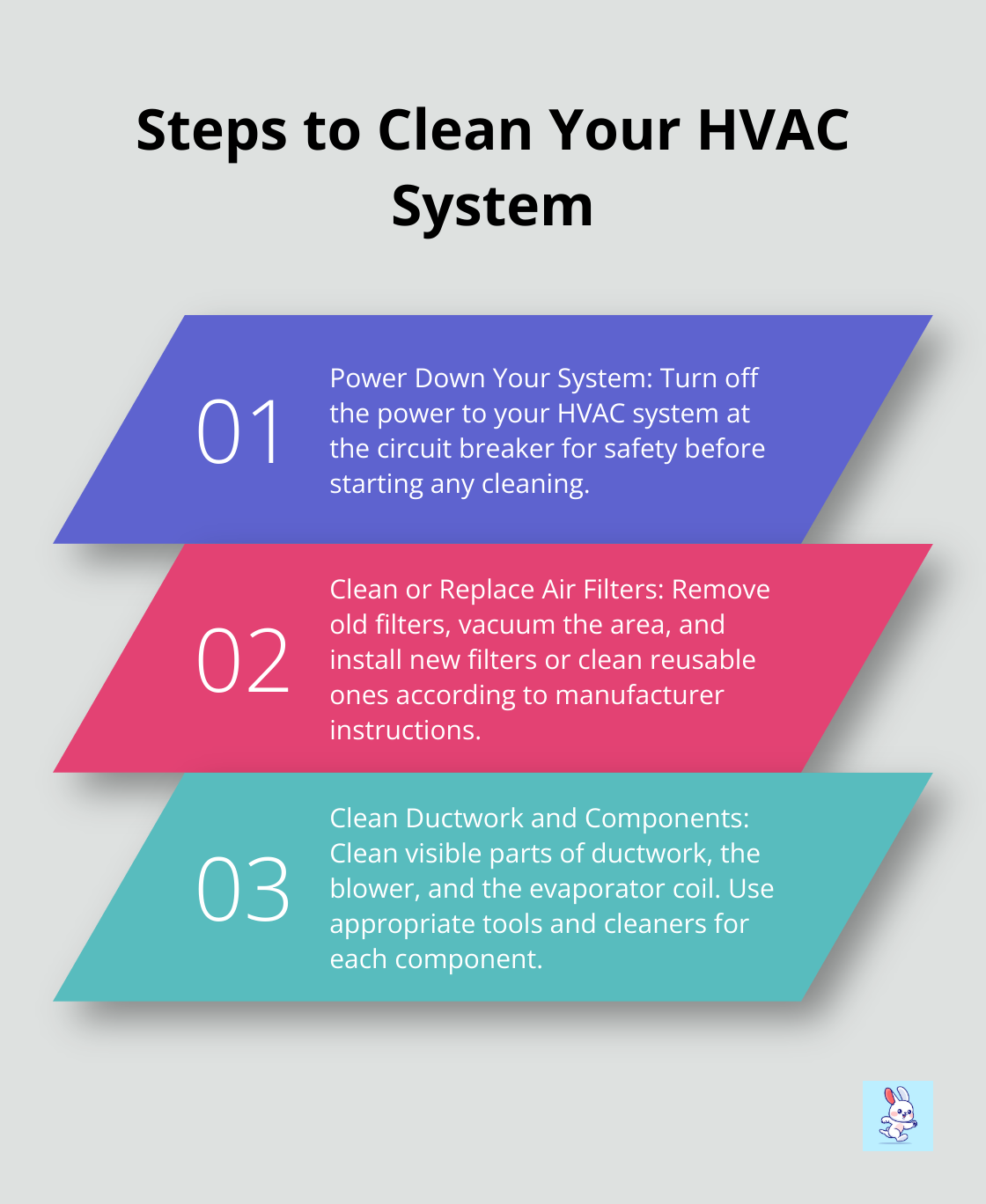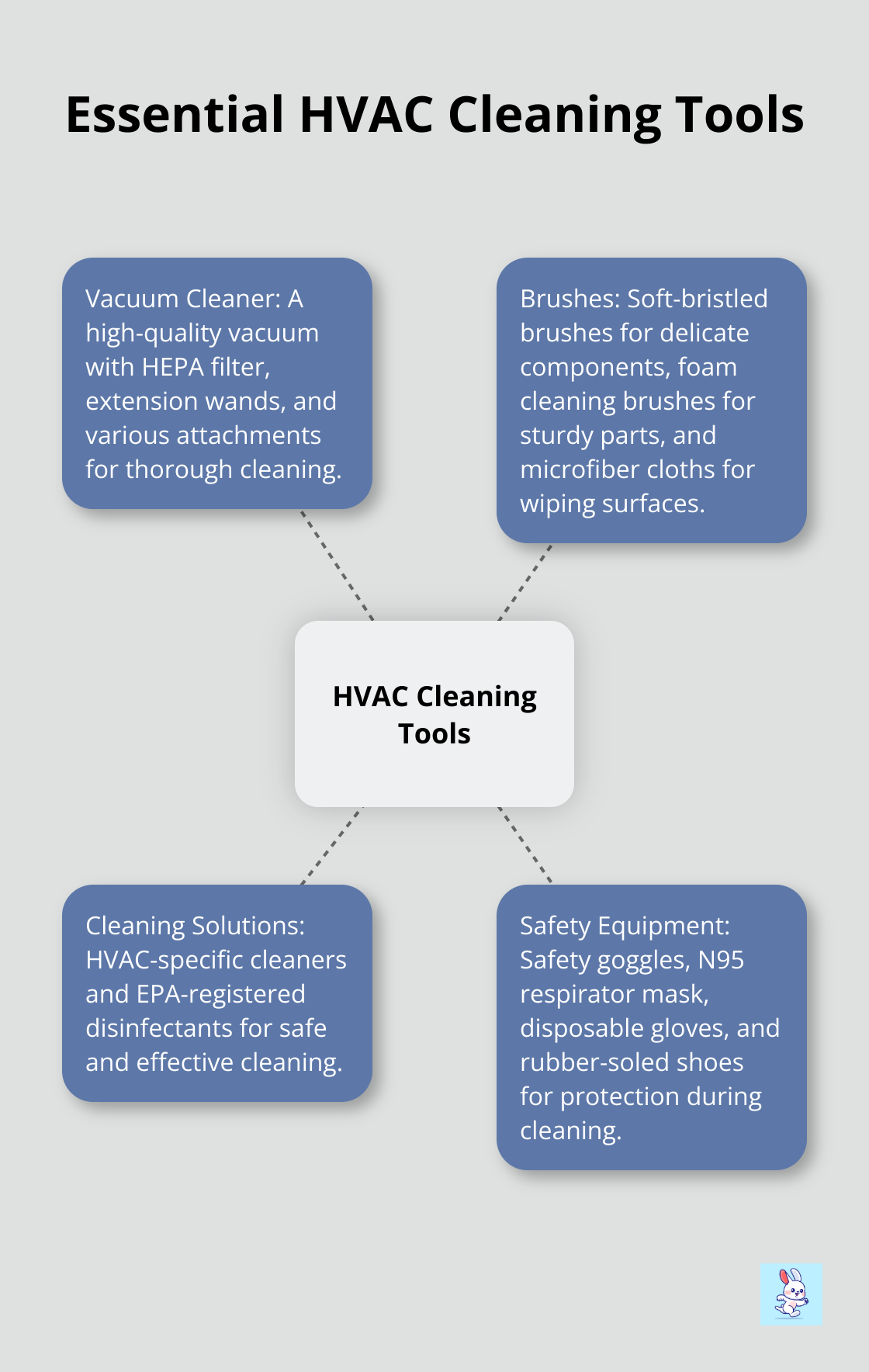At Cleaning Rabbit, we know that cleaning HVAC systems is crucial for maintaining a healthy and efficient home environment.
A well-maintained HVAC system improves air quality, reduces energy costs, and extends the lifespan of your equipment. In this guide, we’ll show you how to clean your HVAC system effectively, step by step.
Get ready to breathe easier and save money on your energy bills.
Why Clean Your HVAC System?
Improved Air Quality for Better Health
Indoor air can contain up to five times more pollutants than outdoor air. Inadequate ventilation can increase indoor pollutant levels by not bringing in enough outdoor air to dilute emissions from indoor sources and not carrying indoor air pollutants out of the area. A dirty HVAC system circulates these contaminants throughout your home, which can worsen allergies and respiratory issues. Clean HVAC systems remove dust, pollen, pet dander, and mold spores from circulation. This removal leads to fewer allergy symptoms and improved overall health for you and your family.

Enhanced Efficiency Equals Energy Savings
Clean HVAC systems operate more efficiently. When your system accumulates dirt and debris, it must work harder to maintain the desired temperature. This extra effort directly translates to higher energy bills. Recent studies have shown that routine HVAC cleaning can impact energy consumption and ventilation performance in buildings.
Longer Lifespan for Your HVAC Investment
HVAC systems represent a substantial investment in your home. Regular cleaning reduces wear and tear on system components. The National Air Duct Cleaners Association (NADCA) suggests that well-maintained HVAC systems can last 15 to 20 years, while neglected ones might need replacement in just 7 to 10 years. Clean systems protect your investment and help you avoid costly early replacements.
Improved System Performance
Clean HVAC systems perform better overall. They maintain more consistent temperatures throughout your home, respond faster to thermostat adjustments, and operate more quietly. This improved performance results in a more comfortable living environment and fewer frustrations with your heating and cooling system.
Reduced Risk of Fire Hazards
Dirty HVAC systems (particularly those with clogged air filters or dusty components) can pose a fire risk. Dust and debris can ignite if they come into contact with heating elements or electrical components. Regular cleaning minimizes this risk, providing an additional layer of safety for your home.
Now that you understand the importance of a clean HVAC system, let’s explore the steps you can take to clean your system effectively and maintain its peak performance.
How to Clean Your HVAC System Step by Step
Cleaning your HVAC system requires attention to detail and safety precautions. Follow these steps for a thorough clean:

Power Down Your System for Safety
Turn off the power to your HVAC system before you start cleaning. This step prevents electrical shock and ensures your safety. Find your circuit breaker and switch off the power to your HVAC unit. If you can’t identify which breaker controls your HVAC system, turn off the main power supply to your home.
Clean or Replace Air Filters
Air filters protect against airborne particles. The EPA suggests changing or cleaning your air filters every 60 to 90 days (more often for homes with pets or in dusty areas). Remove the old filter and vacuum debris around the filter area. Clean reusable filters according to manufacturer instructions. For disposable filters, install new ones that match your system’s specifications.
Clean the Ductwork
Duct cleaning often requires professional equipment. Start by removing vent covers and vacuuming as far into the ducts as possible. Wipe down visible parts of the ductwork with a damp cloth. For a more thorough cleaning, consider hiring a professional service. They use specialized tools to reach deep into your ductwork and remove built-up debris.
Maintain the Blower and Coil
The blower and evaporator coil play critical roles in your HVAC system. To clean the blower, vacuum any visible dust and debris. For the evaporator coil, use a soft brush to remove dirt gently. You can buy no-rinse coil cleaner from most hardware stores. Apply it according to the instructions (usually by spraying it on and letting it drip into the drain pan). This process cleans the coil and helps prevent mold and bacteria growth.
Clear the Condensate Line
A clogged condensate drain line can cause water damage and mold growth. Find the access point to your condensate line (usually a T-shaped plastic pipe near your outdoor unit). Use a wet/dry vacuum to remove debris. Then, flush the line with distilled white vinegar, liquid bleach, hot water, or hydrogen peroxide. However, do not mix bleach and vinegar together as this can create dangerous fumes.
While these steps can improve your HVAC system’s performance significantly, some tasks require professional expertise. If you feel unsure about any step or encounter issues, contact a professional HVAC cleaning service. They have the tools and knowledge to ensure your HVAC system operates at peak efficiency.
Now that you know how to clean your HVAC system, let’s explore the tools and equipment you’ll need for effective HVAC maintenance.
Tools You Need for HVAC Cleaning
Essential Cleaning Tools
A high-quality vacuum cleaner with a HEPA filter is essential for HVAC cleaning. HEPA filters can theoretically remove at least 99.97% of dust, pollen, mold, bacteria, and any airborne particles with a size of 0.3 microns, which prevents dust and allergens from recirculating into your home. You should invest in a vacuum with extension wands and various attachments for hard-to-reach areas.
Soft-bristled brushes are necessary for cleaning delicate components like evaporator coils. Microfiber cloths work well for wiping down surfaces without leaving residue. For stubborn grime, a foam cleaning brush can effectively clean fan blades and other sturdy parts.

Specialized Equipment for Thorough Cleaning
Some specialized tools can enhance your cleaning efforts, although they are not necessary for routine maintenance. A telescoping inspection mirror helps you see into tight spaces, while a digital camera can capture images of hard-to-reach areas for closer inspection.
For duct cleaning, you can rent or purchase a rotary brush system. These tools attach to a drill and can effectively dislodge debris from ductwork. However, comprehensive duct cleaning often requires professional services with industrial-strength vacuum systems (which provide more thorough results).
Cleaning Solutions and Disinfectants
You should choose cleaning solutions specifically designed for HVAC systems. Avoid harsh chemicals that can damage components or leave harmful residues. No-rinse foaming cleaners are effective and easy to use for coil cleaning.
For disinfecting, EPA-registered products are recommended. The EPA provides information on certain registered disinfectants, including links to lists of products registered against common pathogens. You must follow manufacturer instructions and ensure proper ventilation when using any cleaning products.
Safety Equipment
Safety should be your top priority when you clean your HVAC system. Wear safety goggles to protect your eyes from dust and debris. Use a respirator mask rated N95 or higher to avoid inhaling particles. Disposable gloves protect your hands from contaminants and cleaning solutions.
When you work with electrical components, rubber-soled shoes provide insulation. If you access your attic or crawl spaces, knee pads can make the job more comfortable.
These tools can help with basic HVAC maintenance. However, some tasks require professional expertise. For complex cleaning or if you’re unsure about any aspect of HVAC maintenance, you should consult with experts.
Final Thoughts
Cleaning HVAC systems is an essential task that many homeowners neglect. Regular maintenance improves indoor air quality, enhances system efficiency, reduces energy costs, and extends the lifespan of HVAC equipment. We at Cleaning Rabbit offer comprehensive HVAC cleaning services to ensure your system operates at peak performance.
DIY cleaning can be effective for basic maintenance, but professional cleaning services provide a level of thoroughness and expertise that’s hard to match. These experts have specialized tools and knowledge to address complex issues and perform deep cleaning that might challenge homeowners. Professional services can also identify potential problems before they become major issues (saving you money in the long run).
Make HVAC cleaning a regular part of your home maintenance routine. The benefits are clear: improved air quality, lower energy bills, and a longer-lasting HVAC system. Don’t wait for problems to arise; implement these cleaning practices today and experience the difference a well-maintained HVAC system can make in your daily life.

